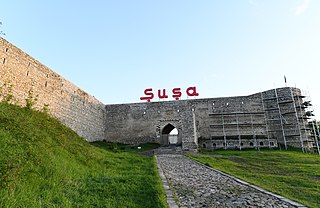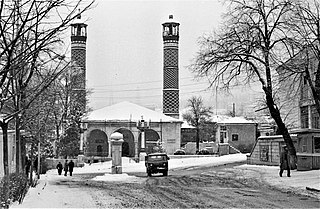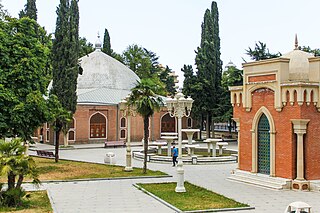
Ganja is Azerbaijan's third largest city, with a population of around 335,600. The city has been a historic and cultural center throughout most of its existence. It was the capital of the Ganja Khanate until 1804; after Qajar Iran ceded it to the Russian Empire following the Treaty of Gulistan in 1813, it became part of the administrative divisions of the Georgia Governorate, Georgia-Imeretia Governorate, Tiflis Governorate, and Elizavetpol Governorate. Following the dissolution of the Russian Empire and the Transcaucasian Democratic Federative Republic, it became a part of the Azerbaijan Democratic Republic, followed by Azerbaijan SSR, and, since 1991, the Republic of Azerbaijan.

Shaki is a city in northwestern Azerbaijan, surrounded by the district of the same name. It is located in the southern part of the Greater Caucasus mountain range, 240 km (150 mi) from Baku. As of 2020, it has a population of 68,400. The center of the city and the Palace of Shaki Khans were inscribed in the UNESCO World Heritage List in 2019 because of their unique architecture and history as an important trading center along the Silk Road.
Javad Khan Qajar ; c. 1748 – 1804) was a member of Ziyadoghlu Qajar, a clan of the Qajar tribe, as well as the sixth and the last khan of the Ganja Khanate from 1786 to 1804 before it was lost to Russia.

Qalaqayın, also known as Galagain or Kalagayny, is a village and the most populous municipality, except for the capital Sabirabad, in the Sabirabad Rayon of Azerbaijan. It has a population of 7,658.
The 1920 Ganja revolt was a popular uprising against the Soviet occupation that took place in Ganja on 26 to 31 May 1920. The goal of the uprising was to liberate Azerbaijan from the Soviet army and put an end to the arbitrariness of the communists. This was the largest rebellion against Soviet rule in Azerbaijan in the 20th century, and caused the most losses. The organisers and leading force of the uprising were officers of the army of the former Azerbaijan Democratic Republic.

The Shusha fortress or Shushi fortress is a fortress surrounding the historical centre of Shusha, also called Shushi. The newly conquered castle town was called "Panahabad fortress" named after Panah Ali Khan who together with Melik Shahnazar was the founder of the fort. In later years, the city was just called "Fortress". A settlement at Shusha is first recorded in a 15th-century illustrated Armenian gospel which mentions the "Shushu village".
The Tuba-Shahi Mosque is a historical and architectural monument of the 15th century located in the Mardakan village of the Khazar district in Baku (Azerbaijan). The mosque is included in the list of the historical and architectural monuments of local importance approved by the Cabinet of Ministers of the Republic of Azerbaijan. It was built not far from the Quadrangular Mardakan Castle dating back to the era of the Shirvanshahs.

Juma Mosque of Shamakhi or Juma Mosque of Shamakhi is a mosque in the city of Shamakhi, Azerbaijan.

Juma Mosque of Ganja or Friday Mosque of Ganja is a mosque located in the centre of Ganja, Azerbaijan. The mosque was built in 1606, according to a project of Sheykh Baheddin Mohammad Amili. The mosque is also often called “Shah Abbas Mosque” because it was built on the instructions of Shah Abbas the Great during his reign.

The siege of Ganja or assault on Ganja was the result of a Russian offensive in the South Caucasus intended to conquer the Ganja Khanate of Qajar Iran, which contributed to the escalation of the Russo-Persian War (1804–1813).
Fatali Khan or Fath Ali Khan of Quba was a khan of the Quba Khanate (1758–1789) who also managed to dominate the Derbent, Baku, Talysh and Shirvan Khanates, as well as the Salyan Sultanate during much of his reign.

Shebeke - are windows filled with coloured glass, created by Azerbaijani folk craftsmen from small wooden parts without glue and nails.

Imamzadeh Mausoleum or Goy Imam Mosque is located 7 km northward to Ganja. It consists of a complex including walls with entrances, small mosques and funerary monuments. The mausoleum, located inside the mosque, bears the grave of Imamzadeh Ibrahim, son of Imam Muhammad al-Baqir, the fifth Imam of Shi'a Muslims.

Chokak Hamam is a historical bath near Juma Mosque in Ganja. Historical-architectural monument built in 1606, by order of Shah Abbas.

The Palace of the Karabakh Khans or the Palace of Panah Ali Khan is a palace located in the historical center of the city of Shusha, the former residence of the founder of the Karabakh Khanate, Panah Ali Khan. During the reign of Panah Ali Khan, the palace was also the residence of the ruler where he lived together with his family. His son, Ibrahimkhalil Khan, together with his family and followers settled in the Palace of Ibrahimkhalil Khan built in the same period. For the eldest son of Ibrahimkhalil Khan, Mukhammedhasan Agha, another palace was built on a sheer cliff in the southeast of the Shusha plateau. In addition to these palaces, the Palace of the Khan's daughter, Natavan, and the Palace of Gara Boyuk khanim, belonging to the Khan's family, were also built in Shusha. Although in various sources the name of the Palace of the Karabakh Khan is attributed to each of these buildings, the main political residence of the Karabakh Khans was the palace-castle of the first Karabakh Khan, Panah Ali Khan.

Meidan is the main city square of Shusha. Starting from Divankhana Square near the Ganja Gate of Shusha fortress, Rasta Bazaar Street, Shusha's main commercial thoroughfare, ends at the Meidan, thus connecting the Meidan and Divankhana.

Shah Abbas Square is a square located in the historical center of the city of Ganja, Azerbaijan. At one time, it was the main memorial complex of the suburb of the Ganja fortress. The complex of Shah Abbas Square was firstly mentioned in the plan of the Ganja fortress of 1797. This architectural ensemble, located in the center of the suburb, consisted of a mosque, a bathhouse and other buildings.
Guba Fortress refers to the fortress walls that once surrounded the historical center of the city of Quba. It was constructed in 1747 after Huseynali Khan of Quba moved the capital of the Quba Khanate from Khudat to Quba. Following the incorporation of the khanate into the Russian Empire, the fortress lost its strategic importance and was used by the local Russian garrison.

Javad was a medieval fortress city of Shirvan in Javad village of Sabirabad District located at the confluence of Kura and Aras. It was founded in the 9th century.















